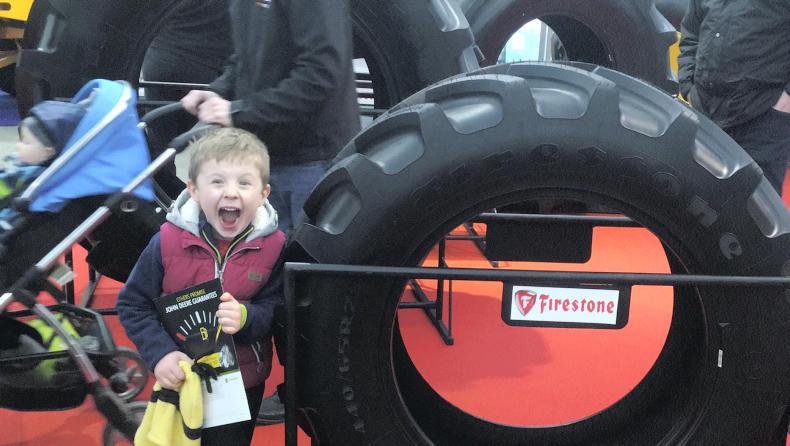The children and I took a trip up to the FTMTA Farm Machinery Show in Punchestown while farm life was still reasonably quiet ahead of lambing.
I have no real need for the majority of machines on offer but it was nice to see a different side to agriculture and explain to Mia and Drew what some of the machines were used for.
My son definitely has keen interest in all things mechanical and was beside himself with excitement during our walk around all the displays. The highlight of his day was a very close inspection of a self-propelled potato harvester. He loves his spuds too, in all their varying forms.
After returning home, I took a trip out through the sheds to check on the ewes and feed out some silage. Two ewes had prolapsed while I was away. It’s not how I wanted to finish off my day but that’s farming.
I try not to stitch ewes if I can help it and find the use of plastic retainers and harnesses sufficient in most cases. I usually try the plastic retainer first as it is easy to put in place and, if ewes are not forcing, more often than not does the job. If the ewe is inclined to force, the harness seems to work better.
With so many different contributory factors leading to prolapse, it is something that usually occurs in the lead up to lambing. I will cull these culprits and their ewe lambs won’t be used for breeding, in an effort to reduce any genetic link.
Preparation for lambing is in full swing around the yard with all available space being used for individual penning and grouping pens. It sometimes feels like a massive game of chess trying to make moves in advance of changing weather and housing conditions.
The first batch of 200 ewes are due to lamb in the next two weeks, followed by the larger group of artificially inseminated ewes and then the lambs and repeats.
However, the birth of lambs is not an exact science and anyone farming sheep will tell you that sheep tend to do their own thing, so we had a surprise early arrival of twins last week. Mia and Drew were so excited.
Out in the fields, grass is doing well with an average farm cover of 716kg DM/ha.
The forage rape that the ewe lambs are grazing is nearly finished. I will probably leave them out on the stubble fields for another few weeks with access to quality silage and I will probably increase their meal to compensate for the rape.
This week, I hope to have my vet calling out to complete my flock health plan for the KT programme before the ewes get into the swing of things. It would be great to have a few of these jobs done while I still have time to look at them.
The children and I took a trip up to the FTMTA Farm Machinery Show in Punchestown while farm life was still reasonably quiet ahead of lambing.
I have no real need for the majority of machines on offer but it was nice to see a different side to agriculture and explain to Mia and Drew what some of the machines were used for.
My son definitely has keen interest in all things mechanical and was beside himself with excitement during our walk around all the displays. The highlight of his day was a very close inspection of a self-propelled potato harvester. He loves his spuds too, in all their varying forms.
After returning home, I took a trip out through the sheds to check on the ewes and feed out some silage. Two ewes had prolapsed while I was away. It’s not how I wanted to finish off my day but that’s farming.
I try not to stitch ewes if I can help it and find the use of plastic retainers and harnesses sufficient in most cases. I usually try the plastic retainer first as it is easy to put in place and, if ewes are not forcing, more often than not does the job. If the ewe is inclined to force, the harness seems to work better.
With so many different contributory factors leading to prolapse, it is something that usually occurs in the lead up to lambing. I will cull these culprits and their ewe lambs won’t be used for breeding, in an effort to reduce any genetic link.
Preparation for lambing is in full swing around the yard with all available space being used for individual penning and grouping pens. It sometimes feels like a massive game of chess trying to make moves in advance of changing weather and housing conditions.
The first batch of 200 ewes are due to lamb in the next two weeks, followed by the larger group of artificially inseminated ewes and then the lambs and repeats.
However, the birth of lambs is not an exact science and anyone farming sheep will tell you that sheep tend to do their own thing, so we had a surprise early arrival of twins last week. Mia and Drew were so excited.
Out in the fields, grass is doing well with an average farm cover of 716kg DM/ha.
The forage rape that the ewe lambs are grazing is nearly finished. I will probably leave them out on the stubble fields for another few weeks with access to quality silage and I will probably increase their meal to compensate for the rape.
This week, I hope to have my vet calling out to complete my flock health plan for the KT programme before the ewes get into the swing of things. It would be great to have a few of these jobs done while I still have time to look at them.






 This is a subscriber-only article
This is a subscriber-only article











SHARING OPTIONS: